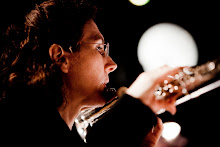Classical Contemporary Music which is abstract, atonal or just plain impenetrable may demand something beyond the traditional idea of instrumantal expression we are taught as flutists (the use of vibrato, tonal colors, dynamics and so on). Here are some random tips on how to tap into other sources for musical ideas.
Studying works that are outside the tradition of virtuosity can help you to focus on producing expression and dramatic impact. Extreme minimalist music or graphically notated music, for example, is divorced from ideas of technical wizardry; therefore one has to concentrate on aspects of timing, bodily movement, manner of breathing, and concentration. The difficulty is to find a way of generating intensity and maintaining interest throughout a work that may be nothing but a series of bizarre noises. Some examples of this type of music are certain works by John Cage (solos from Song Books, the flute part to Concert for Piano, which can be played as a solo or in conjunction with other works by Cage), Earle Brown (December 1958) or Cornelius Cardew (Treatise). Finding expressive solutions to these scores is a good exercise for stretching your musical imagination. Having travelled to this strange land of extremes can give you great perspective upon return.
To capture the particular expressive and dramatic style of the composer, I often rely on a practice idea that I picked up from Robert Dick: Play a passage of the piece you are working on, then turn the music away from you and improvise a passage in the same style, using the same range, dynamic inflections, length of phrases, etc. Once you've put yourself through this creative process, go back to the written passage. I always find something fresh to consider - perhaps a new inflection, a different color progression, or maybe a new sense of rhythmic clarity.
When searching for expressive solutions, the world of the visual arts can sometimes provide interesting insights. Here is one example of how visits to museums helped me to solve an expressive problem: While working on the Berio Sequenza from memory I started to wonder, what does one actually do with the mind while performing? Some performers may have a photographic memory and are able to visualize the score during performance. Not having this ability, I needed something to focus on, to keep my visual area from being distracted by the audience. (Playing with your eyes closed is not a good option when trying to communicate).
I do see this as a problem of expression: from the point of stage choreography, playing solos from memory is a challenge for flutists. Pianists are in profile, violinists are also a bit angled so their f-holes are facing the audience. Even clarinetists can pretend to look down at their fingers. And unlike singers, we do not have total facial freedom, nor can we hide behind a mask of facial expression (the bottom half of our face being otherwise engaged). We also do not have the words to carry the expression. Since we face the audience directly, we need a special courage and a strong method of focus. Of course, you can focus on the "exit" sign at the back of the hall, but still, what are you doing with your mind? I don't want to be thinking of the "exit" sign!
One tells children to "think up a story" as an aid to performance. However, that hardly seemed appropriate for a work such as the Sequenza, and could prove even more distracting than the audience. What helped in the end was to allow abstract images to form on their own, inspired and dependent on the sounds I produced during performance. This allowed me to concentrate on the actual sounds I was producing and not be distracted by any preconceived, representational, artificially imposed images or thoughts.
These images that I formed were inspired by visits to the Stedelijk and Van Gogh museums in Amsterdam, where I was living at the time. I was also able to think of a color scheme and progression that helped me through the opening of Franco Donatoni's Midi, which can otherwise seem like a salad of endless noodles.
In yoga, the focus of your eyes is called drishti. Sometimes it is straight ahead, sometimes the tip of your nose, sometimes your belly button (not recommended for flutists!). Do whatever it takes to develop your own drishti. Be relaxed in the focus of your eyes, this will help you to concentrate.
Subscribe to:
Post Comments (Atom)


Great post, Helen. I end up doing such a large amount of rep that performing from memory is rarely an option. It might be useful to note that the concerns you raise aren't of less importance if the music is in front of you. My goal is ususually some version of relying on looking at the score as little as possible, i.e. knowing my music well enough that the music is there more to provide comfort and reminders than something to be buried in.
ReplyDeleteAnd, as you point out, when doing music might be described as "non-narrative", finding the right kind of focus and providing the audience with a picture that enhances their listening is a special challenge.
I appreciate your insights...carry on!
This comment has been removed by the author.
ReplyDeleteYou're right Tod, the concerns *are* present even with the music.
ReplyDeleteI like the notion of the "non-narrative". Although I mentioned storytelling I wasn't thinking in such concrete literary terms but it is indeed appropriate. Yet another source to tap into perhaps? Thanks for your feedback.